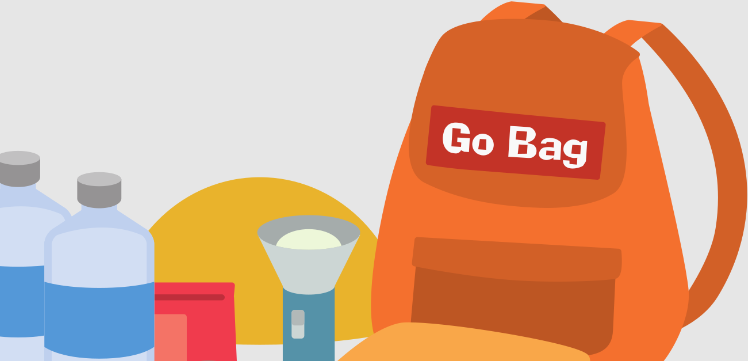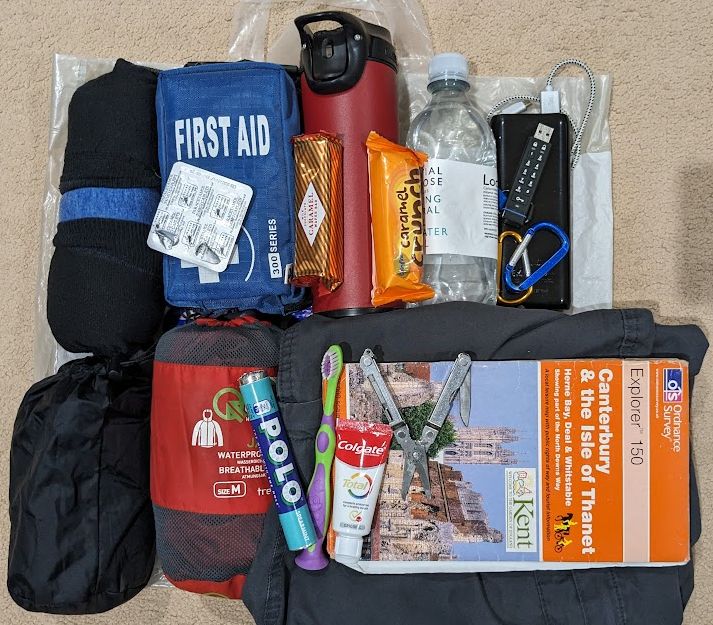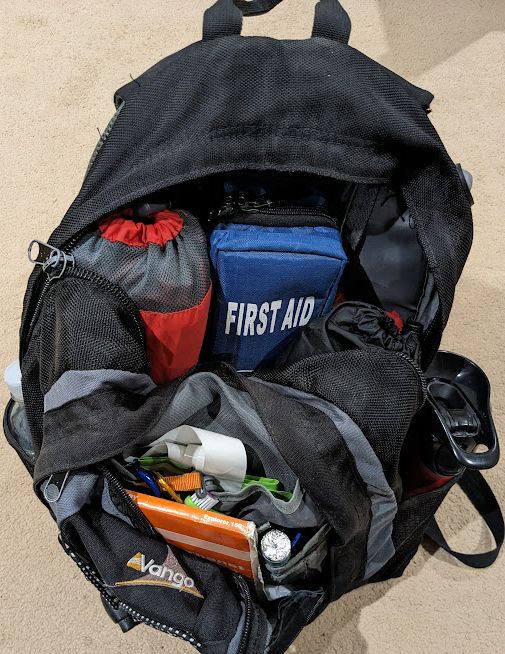Thought exercise: Making a go bag
Disclaimer: This is a thought exercise, not advice!

I started writing this post in 2021, and had started to think about being more prepared after watching people panic buy as we entered lockdown. During one of the 2021 lockdowns, after my wife injured her ankle on boxing day and needed to visit hospital, I quickly threw a number of items into a bag for her - flask of tea, book, extra clothes (she was in running gear) etc. Being the Christmas holiday season, and the covid measures in place at the time, there was likely to be a long wait at the hospital so having some supplies seemed a very good idea. This got me thinking: what would I put in a go bag [1] if we had to leave the house in a hurry? Since then we've had a few hospital trips (all is well fortunately) and a very basic grab bag has travelled with us. In this post I'll cover the basic grab bag but also my thoughts on a longer term bag.
Disclaimer: This post is meant as a thought exercise only, and is not health or survival advice. You should consult other sources if you are after survival tips.
I wrote a blog post previously about making a cyber security incident response go bag, in case you're interested 🙂.
The basic bag
I'd expect that our most likely scenario for needing a go bag is a hospital trip. We don't live any area susceptible to earthquakes, extreme weather or flooding (if we've flooded, up this hill, the rest of the city has problems) so we're not likely to need to fully "bug out" [2]. When going to hospital there's no guarantee the canteen will be open, or the little shop, so some food and water was needed. A few other bits and pieces made the list too:
- Bottled water
- Spare house key
- Battery pack with cables for charging phone
- Sweets (quick sugar)
- Crisps (quick snack)
If there's time on leaving, the following things get added:
- Book or eBook reader (waiting in the hospital can take a long time!)
- Camelbak Forge full of tea
- Sandwich
- Music player (or headphones to listen to music on the phone)
With the exception of the sandwich and key, the above list is pretty much all laid out below - it's not much.

As you can see, this is more about leaving quickly with some useful things, rather than surviving away from home for a while. Fortunately this isn't too heavy, and fits in a standard rucksack (25 litre) with plenty of space spare as you can see below. If you're thinking about putting something like this together, consider that sometimes people get separated from their belongings in hospital. Don't write your address on your spare house key (ever!), and consider the cost of replacements if you lose your backup battery / music player / eBook reader.

Risk profiles
When I was thinking about a more extensive bug out bag (can you tell that sometimes I cannot sleep?) I did some research after making a list of my own, to see how they compared. A key finding in my research was to consider your risk profile - something I do at work and certainly did during the pandemic!
A risk profile describes the risks you think you're likely to encounter and your appetite / responses to them. I've already given the example of not living in an area with extreme weather, but if you do then you'd need to factor extreme weather into your thinking. On the more extreme end of the scale, I must have been reading an American site, risk profiles can include the need to protect yourself with a handgun. Not an option in the UK, or a particular risk, so not something I needed to include.
So, what would be in my bag?
Disclaimer: This post is meant as a thought exercise only, and is not health or survival advice.
My first list, prior to my research stood at:
- Rucksack, likely a 25 litre one
- USB stick with copies of documents, bank details, ID (encrypted)
- 2x climbing carabiners (useful for attaching to things, and possibly rescue)
- Tow rope (strong enough to climb with)
- Camelbak Forge (to hold hot drinks and keep them hot for hours)
- Bottle of water (on the assumption I won't have clean drinking water immediately)
- Clothes in plastic bag (not many, and the plastic bag to waterproof them)
- Sewing kit (for repairs)
- Water purification tablets
- Basic first aid kit
- Paracetamol
- Knife / multi-tool
- Compass
- Map of area
- Cash (concealed)
- Mirror (for signalling, not checking my hair!)
- Backup battery (for charging electronics on the go)
- Cereal bars and basic rations
- Waterproof coat & trousers
- Safety pins & matches
- Basic toiletries (tooth brush, tooth paste, soap)
Looking at that list while I write this post I'm doubting that would fit in my bag, so I tried to model it. Note that not everything in the photo is sufficient grade (those carabiners aren't rated for climbing, etc.), and I didn't have everything on my list available:


(Yes, I ate one of the chocolate bars after taking the photo...)
Even with some items missing, what's in the photo weighs approximately four kilograms. Add in the missing items, and make sure you're using the right things (appropriate grade) and I'd guess we were looking at five kilograms or more.
Looking at some online resources I found I'd planned for a completely different set of scenarios. For example, I've assumed I'm still going to have shelter and the ability to make heat yet one list online said a basic bag should include the ability to start a fire, and included a tarp to make a shelter. I've included a tow rope, they suggest paracord. Both could be used to make a shelter, but in my list there's nothing but rope to make a shelter with! I didn't include a torch - I was probably thinking I could use my phone but that's a very power hungry torch. I'm also carrying a lot less water than is suggested.
Reading my list it feels as though my target scenario is confused. Am I likely to be climbing with the rope and carabiners? Not particularly likely in my area. Similarly the signal mirror isn't likely to be much use either.
Further reading
This sort of thinking, for me, seems to have been a side-effect of the pandemic. During the lockdowns with shortages of foods, and the news that people were hoarding toilet paper (!), I found the concept of "prepping" interesting and did a lot of reading. I haven't got an underground hideout, or a cabin in some remote woodland with enough food for years, but my reading did flag to me that being prepared for disruption was no bad thing. That said, I haven't made a bug out bag either.
It seems this concept is more popular in America, or at least there are lots of blog posts and websites from there, so it's worth remembering that there will be differences in legislation and risk.
If you're interested in further reading, you could take a look at The Prepared which has some interesting articles and seems to be sensibly thought out:
- https://theprepared.com/bug-out-bags/guides/bug-out-bag-list/
- https://theprepared.com/prepping-basics/guides/emergency-preparedness-checklist-prepping-beginners/
- https://theprepared.com/bug-out-bags/guides/bob-vs-inch/
Banner image: Emergency management woman by Juhele on OpenClipart.org
[1] I'll use "go bag", "grab bag" and "bug out bag" interchangeably. Whether or not there's a specific difference between them I don't know.
[2] To "bug out" is to leave in a hurry. It's also the title of a fantastic M*A*S*H episode. Those familiar will understand the line "I think I just did".

